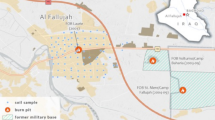Abstract
Wheat is staple food of the people of Pakistan. Phosphate fertilizers, used to increase the yield of wheat, enhance the natural radioactivity in the agricultural fields from where radionuclides are transferred to wheat grain. A study was, therefore, carried out to investigate the uptake of radioactivity by wheat grain and to determine radiation doses received by human beings from the intake of foodstuffs made of wheat grain. Wheat was grown in a highly fertilized agricultural research farm at the Nuclear Institute of Agriculture and Biology (NIAB), Faisalabad, Pakistan. The activity concentration of 40K, 226Ra and 232Th was measured in soil, single superphosphate (SSP) fertilizer, and wheat grain using an HPGe-based gamma-ray spectrometer. Soil to wheat grain transfer factors determined for 40K, 226Ra and 232Th were 0.118 ± 0.021, 0.022 ± 0.004 and 0.036 ± 0.007, respectively, and the annual effective dose received by an adult person from the intake of wheat products was estimated to be 217 μSv.

Similar content being viewed by others
References
Tzortzis M, Tsertos H, Christofides S, Christodoulides G (2003) Radiat Meas 37:221
Ziqiang P, Yin Y, Mingqiang G (1998) Radiat Prot Dosim 24:29
Tufail M, Akhtar N, Waqas M (2006) Radiat Meas 41:443
Tufail M, Akhtar N, Waqas M. (2006) Health Phys 90:361
Khan K, Khan HM, Tufail M, Ahmad N (1997) Nucl Sci J 34:455
Carini F (2001) J Environ Radioact 52:237
Tufail M, Akhtar N, Sabiha-Javied, Hamid T (2007) J Radiol Prot 27:481
IAEA (1989) Measurement of radionuclides in food and the environment, a guidebook. Technical Report Series (TRS) No 295. International Atomic Energy Agency (IAEA), Vienna, Austria
AQCS (2000) Radionuclides and trace elements in soil. Reference Material IAEA-375. Analytical Quality Control Services (AQCS) of International Atomic Energy Agency (IAEA), Vienna, Austria
Tufail M (1992) Radon and gamma activity measurements for determination of radiation doses, assessment of cancer risks, and applications to geology/geophysics. Ph.D. Thesis, Department of Physics, University of the Punjab, Lahore, Pakistan
Knoll GF (2000) Radiation detection and measurement, 3rd edn. Wiley, New York
Gilmore GR (2008) Practical gamma-ray spectrometry, 2nd edn. Wiley, New York
Ali S, Tufail M, Jamil K, Ahmad A, Khan HA (1996) Sci Total Environ 187:247
Akhtar N, Tufail M, Ashraf M, Iqbal MM (2005) Radiat Meas 39:11
Akhtar N, Tufail M (2007) Radiat Prot Dosim 123:103
Asghar M, Tufail M, Sabiha-Javied, Abid A, Waqas M (2008) J Radiol Prot 28:387
Eisenbud M, Gesell T (1997) Environmental radioactivity from natural, industrial, and military sources, 4th edn. Academic Press, San Diego, USA
UNSCEAR (2000) Sources and effects of ionizing radiation. United Nations Scientific Committee on the Effects of Atomic Radiation, Report to the General Assembly with Scientific Annexes, United Nations, New York
Akhtar N, Tufail M, Choudry MA, Orfi SD (2004) Nucleus 41:1
Ehlken S, Kirchner G (2002) J Environ Radioact 58:97
Scheibel V, Appoloni CR, Schechter H (2006) J Radioanal Nucl Chem 270:163
Pulhani VA, Dafauti S, Hegde AG, Sharma RM, Mishra UC (2005) J Environ Radioact 79:331
Misdaq MA, Bourzik W (2004) J Radiol Prot 24:391
Pietrzak-Flis Z, Rosiak L, Suplinska MM, Chrzanowski E, Dembinska S (2001) Sci Total Environ 273:163
Akther J, Mahmood K, Malik KA, Mardan A, Ahmad M, Iqbal MM (2004) Plant, Soil Environ 50:463
Acknowledgments
One of the authors, Sabiha-Javied, acknowledges the Higher Education Commission (HEC) of Pakistan and appreciates its financial support through “Indigenous Scholarship Scheme for Ph.D. studies in Science and Technology”.
Author information
Authors and Affiliations
Corresponding author
Rights and permissions
About this article
Cite this article
Tufail, M., Sabiha-Javied, Akhtar, N. et al. Assessment of annual effective dose from natural radioactivity intake through wheat grain produced in Faisalabad, Pakistan. J Radioanal Nucl Chem 283, 585–590 (2010). https://doi.org/10.1007/s10967-009-0391-1
Received:
Published:
Issue Date:
DOI: https://doi.org/10.1007/s10967-009-0391-1




